GIBRALTAR
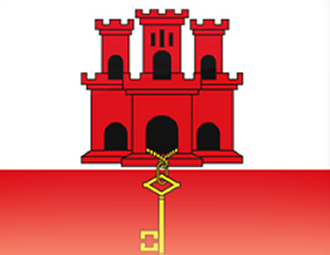
Gibraltar is a British overseas territory at the southern end of the Iberian Peninsula at the entrance to the Mediterranean Sea.
An interesting aspect of Gibraltar’s history is that it was inhabited by Neanderthals from around 128,000 BC, and it is believed to be the last hold out of the Neanderthals in the area. The Neanderthals survived in Gibraltar until around 24,000 BC.
Gibraltar experienced the same occupations as surrounding areas during the 1st millennium BC and the first half of the 1st millennium AD. It was occupied by the Phoenicians, Carthaginians, Roman Empire, and Vandals. It came under Islamic rule in 711 AD, and remained so until the 15th century.
Spain ruled Gibraltar in the 16th and 17th centuries, but they lost it to Anglo-Dutch forces in 1704 during the Spanish War of Succession. It was subsequently ceded to Britain in 1713. Spain tried unsuccessfully to reclaim it in the late 18th century.
Sovereignty of Gibraltar remains an issue of contention between Spain and Britain. Spain continues to claim the territory, but Gibraltarians overwhelmingly reject those claims and prefer to be under the sovereignty of Britain. The border between Spain and Gibraltar was closed in 1969, and it was not fully reopened until 1985.
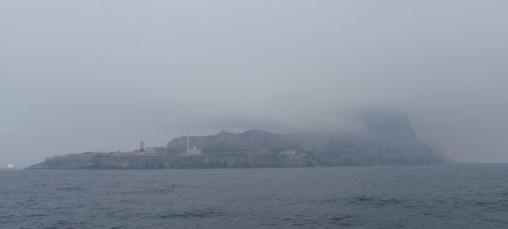
Our first foggy look at Gibraltar
Gibraltar has an area of only 2.6 square miles. It has a border 0.75 miles long with La Linea in Andalusia, Spain, and it has a shoreline of 7.5 miles. It is known for the Rock of Gibraltar which is 1,398 feet tall.
The government in Gibraltar is a unicameral parliament. Queen Elizabeth II is the head of state. They are a member of the EU.
Gibraltar’s location was previously considered particularly important militarily, and 70% of its economy was related to military spending. That, however, has decreased to only 7%. Its main sources of income are now tourism, financial services, internet gaming, and shipping.
Its currency is the Gibraltar pound which is equivalent in value to the British pound sterling. There is no VAT charged in Gibraltar.
The population of Gibraltar is approximately 30,000. It is very densely populated. Native Gibraltarians have full British citizenship.
The population is ethnically diverse with 27% British, 24% Spanish, 20% Italian, 10% Portuguese, 8% Maltese, and 4% other. The official language is English, but many speak Spanish. Many also speak a local vernacular called Llanto which is a mix of Spanish, English, Maltese, Portuguese, and Italian. They are 78% Catholic.
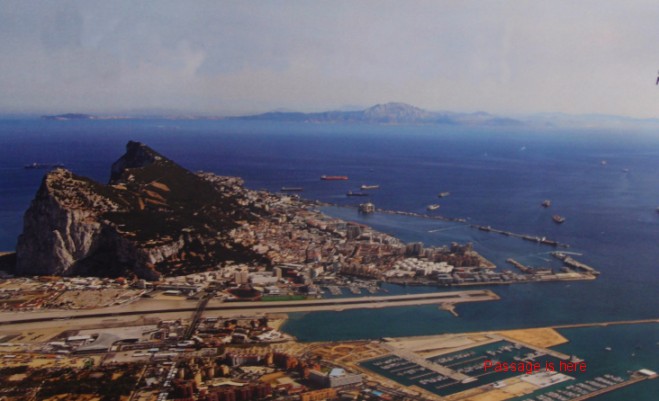
An overview of Gibraltar with La Linea Marina in the lower right corner
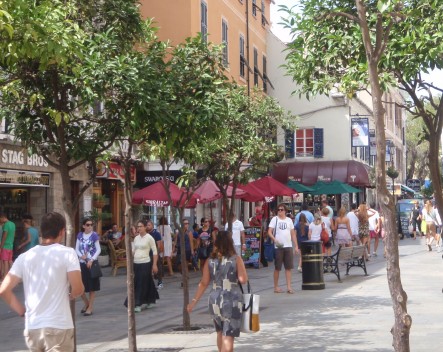
Another shoppers’ paradise
The morning we sailed around Gibraltar had been very foggy, and many clouds remained as we rounded Europa Point. We could not see much of Gibraltar from the water, so we planned on seeing it from land.
Gibraltar has a marine industry lacking in La Linea, Spain, so we have gone across the border to the chandleries a few times. They are small and expensive, but they are able to provide products simply not available on the Spanish side of the border.
Crossing the border is easy on foot (a bit more time consuming for those that choose to drive). As soon as you are across the border, you are walking up Winston Churchill Boulevard. This main thoroughfare runs directly across the only runway for the Gibraltar Airport. There are few daily flights – less than ten? – and all go to England. The flights stop all traffic (foot and auto) when they need the runway. Nonetheless, it is an eerie experience walking across a live runway. We have read that this airport is the most dangerous in Europe and the fifth most dangerous in the world. Although we do not know the criteria for making those rankings, we doubt running over pedestrians is among them.
Town is cramped with shops. They cater to the British tourist, and they have hundreds of shops selling clothing, electronics, etc. There are many restaurants as well, but we still have not found good fish and chips.
The Rock of Gibraltar is a tourist draw, and there is a tram that runs up the rock. Many take it to see the Barbary macaques that live on the rock. Although these animals do not have tails, they are monkeys and not apes. They are the last wild monkeys in Europe. There are about 230 of them that live on the rock, and they occasionally come down in to town and create havoc. We were around enough macaques in Malaysia that we are no longer amused by them (they can be quite nasty), but we have seen them in town a few times – behaving themselves.
Cruise ships often visit Gibraltar, and we have tried to avoid town on those days. But Nita needed to go across one day when two ships were in – what madness!
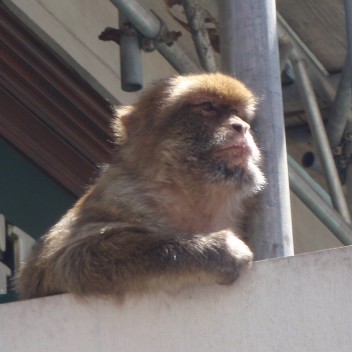
A Barbary macaque visiting town
We have a small built-in computer on Passage that runs our navigation system and much of our lives. The hard disc had been giving signs of impending failure, and we planned to replace it soon. However, the threat of failure suddenly escalated, so we decided to replace it before leaving La Linea. We found a shop in Gibraltar, NetGear, that cloned our drive and replaced it in less than 24 hours. It was a bit more expensive than we had hoped, but most things in Gibraltar are. We will gladly pay a few dollars more to avoid another catastrophic disk failure like we had a few years ago.
We did actually take Passage in to Gibraltar briefly to buy fuel, but all we did was take on fuel and leave. Fuel there is duty-free and considerably less expensive than in La Linea. We took on 80.32 gallons for $427.90 USD. That is a cost of $5.33 USD per gallon, and that is the least we have paid in a very long time. But Passage’s trip to Gibraltar was only a very quick stop for fuel, then back to La Linea.
Were it not for the chandleries and computer crises, we would not bother with Gibraltar at all. It lacks the personality and warmth of La Linea. But we do need a semi-constant supply of boat parts, so…
Return to our land travel page or jump next door to mainland Spain.